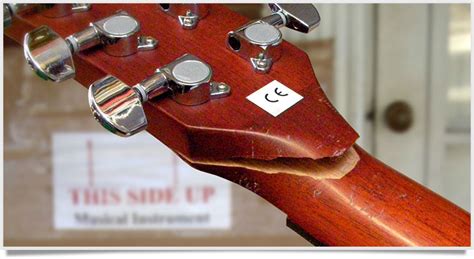Shipping Your Guitar: Avoid These Common Pitfalls
Shipping a guitar can be a nerve-wracking experience. This delicate instrument, a source of joy and musical expression, deserves the utmost care during transit. One wrong move can lead to costly repairs or even irreparable damage. This comprehensive guide will walk you through the common pitfalls to avoid, ensuring your beloved guitar arrives safely at its destination.
What are the Risks of Shipping a Guitar?
Before diving into preventative measures, let's acknowledge the inherent risks involved. Guitars are susceptible to damage from:
- Rough Handling: Bumps, drops, and general mishandling during transit are significant threats.
- Temperature Fluctuations: Extreme heat or cold can warp the wood, affecting playability and tone.
- Humidity Changes: Sudden shifts in humidity can cause cracks in the wood or affect the glue joints.
- Pressure and Impact: Internal pressure changes during air travel and impacts from other packages can cause serious damage.
How to Properly Pack a Guitar for Shipping
Proper packing is paramount. A poorly packed guitar is a recipe for disaster.
Choosing the Right Case:
- Hard-Shell Case: This is absolutely essential. A gig bag offers minimal protection and should never be used for shipping. A high-quality hard-shell case with strong latches and ample padding is your first line of defense.
- Case Condition: Inspect your case for any cracks, broken latches, or weakened areas before use. Repair or replace it if necessary.
Internal Padding:
- Extra Padding: Even within a hard-shell case, additional padding is crucial. Use bubble wrap, foam padding, or packing peanuts to fill any empty spaces inside the case. This prevents the guitar from shifting during transit.
- Neck Support: Pay special attention to the neck. Use padding to securely support it and prevent it from bending or breaking.
Exterior Packaging:
- Sturdy Outer Box: Your guitar case should be placed inside a sturdy corrugated cardboard box that's significantly larger than the case itself. This provides an extra layer of protection against impacts.
- Packing Materials: Fill the space between the case and the outer box with copious amounts of packing peanuts or bubble wrap. Ensure the case is completely immobile within the box.
- Fragile Labeling: Clearly label the box as "Fragile," "Handle with Care," and "Musical Instrument." Use multiple labels on all sides of the box for maximum visibility.
What Kind of Shipping Method Should I Use?
Choosing the right shipping method is vital.
Ground Shipping vs. Air Shipping:
- Ground Shipping: Generally safer, as it involves less handling and fewer sudden changes in pressure and temperature. However, it is slower.
- Air Shipping: Faster but exposes the guitar to greater risks due to pressure changes and rougher handling. Only opt for air shipping if absolutely necessary and ensure the packaging is exceptionally robust.
Insuring Your Shipment:
- Insurance Coverage: Always insure your guitar for its full replacement value. This protects you financially in case of loss or damage during transit. Clearly document the instrument's value with photos and receipts.
H2: What if My Guitar Arrives Damaged?
Despite your best efforts, damage can still occur.
Inspect Upon Arrival:
- Thorough Inspection: Carefully inspect the package and the guitar immediately upon arrival. Take photos or videos of any damage to the box or the instrument itself.
- Document Everything: Note the condition of the packaging, any visible damage to the case or guitar, and the condition of any accompanying paperwork.
- File a Claim: Immediately file a claim with the shipping carrier and provide them with all the necessary documentation.
Frequently Asked Questions (PAA)
Q: Can I ship a guitar internationally? A: Yes, you can, but it's significantly more complex and risky. International shipping requires extra paperwork, customs declarations, and careful adherence to regulations. Be prepared for higher shipping costs and increased potential for damage or loss. The added complexity makes insuring the package even more critical.
Q: What is the best time of year to ship a guitar? A: Avoiding extreme temperatures is key. Shipping during milder seasons (spring or fall) generally minimizes the risk of temperature-related damage.
Q: Can I use recycled packing materials? A: While recycling is great for the environment, it's best to use new packing materials when shipping a valuable instrument like a guitar. Recycled materials may not offer sufficient protection.
Q: How much does it cost to ship a guitar? A: The cost varies greatly depending on the size and weight of the package, the distance it's traveling, the shipping method (ground vs. air), and the level of insurance coverage. It's always best to get quotes from several shipping carriers.
By following these guidelines and taking the necessary precautions, you can significantly increase the chances of your guitar arriving safely at its destination. Remember, prevention is always better than cure, and a little extra care goes a long way in protecting your precious instrument.

